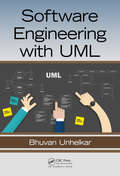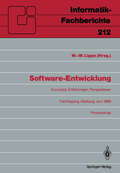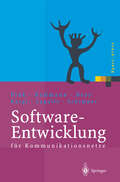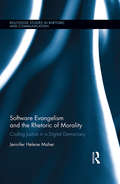- Table View
- List View
Software Engineering with Computational Intelligence (Studies in Fuzziness and Soft Computing #121)
by Jonathan LeeIt is not an exaggeration to view Professor Lee's book," Software Engineer ing with Computational Intelligence," or SECI for short, as a pioneering contribution to software engineering. Breaking with the tradition of treat ing uncertainty, imprecision, fuzziness and vagueness as issues of peripheral importance, SECI moves them much closer to the center of the stage. It is ob vious, though still not widely accepted, that this is where these issues should be, since the real world is much too complex and much too ill-defined to lend itself to categorical analysis in the Cartesian spirit. As its title suggests, SECI employs the machineries of computational intel ligence (CI) and, more or less equivalently, soft computing (SC), to deal with the foundations and principal issues in software engineering. Basically, CI and SC are consortia of methodologies which collectively provide a body of con cepts and techniques for conception, design, construction and utilization of intelligent systems. The principal constituents of CI and SC are fuzzy logic, neurocomputing, evolutionary computing, probabilistic computing, chaotic computing and machine learning. The leitmotif of CI and SC is that, in general, better performance can be achieved by employing the constituent methodologies of CI and SC in combination rat her than in a stand-alone mode. In what follows, I will take the liberty of focusing my attention on fuzzy logic and fuzzy set theory, and on their roles in software engineering. But first, a couple of points of semantics which are in need of clarification.
Software Engineering with OBJ: Algebraic Specification in Action (Advances in Formal Methods #2)
by Joseph A. Goguen Grant MalcolmSoftware Engineering with OBJ: Algebraic Specification in Action is a comprehensive introduction to OBJ, the most widely used algebraic specification system. As a formal specification language, OBJ makes specifications and designs more precise and easier to read, as well as making maintenance easier and more accurate. OBJ differs from most other specification languages not just in having a formal semantics, but in being executable, either through symbolic execution with term rewriting, or more generally through theorem proving. One problem with specifications is that they are often wrong. OBJ can help validate specifications by executing test cases, and by proving properties. As well as providing a detailed introduction to the language and the OBJ system that implements it, Software Engineering with OBJ: Algebraic Specification in Action provides case studies by leading practitioners in the field, in areas such as computer graphics standards, hardware design, and parallel computation. The case studies demonstrate that OBJ can be used in a wide variety of ways to achieve a wide variety of practical aims in the system development process. The papers on various OBJ systems also demonstrate that the language is relatively easy to understand, implement, and use, and that it supports formal reasoning in a straightforward but powerful way. Software Engineering with OBJ: Algebraic Specification in Action will be of interest to students and teachers in the areas of data types, programming languages, semantics, theorem proving, and algebra, as well as to researchers and practitioners in software engineering.
Software Engineering with Reusable Components
by Johannes SametingerThe book provides a clear understanding of what software reuse is, where the problems are, what benefits to expect, the activities, and its different forms. The reader is also given an overview of what sofware components are, different kinds of components and compositions, a taxonomy thereof, and examples of successful component reuse. An introduction to software engineering and software process models is also provided.
Software Engineering with UML
by Bhuvan UnhelkarThis book presents the analysis, design, documentation, and quality of software solutions based on the OMG UML v2.5. Notably it covers 14 different modelling constructs including use case diagrams, activity diagrams, business-level class diagrams, corresponding interaction diagrams and state machine diagrams. It presents the use of UML in creating a Model of the Problem Space (MOPS), Model of the Solution Space (MOSS) and Model of the Architectural Space (MOAS). The book touches important areas of contemporary software engineering ranging from how a software engineer needs to invariably work in an Agile development environment through to the techniques to model a Cloud-based solution.
Software Engineering with UML
by Bhuvan UnhelkarThis book presents the analysis, design, documentation, and quality of software solutions based on the OMG UML v2.5. Notably it covers 14 different modelling constructs including use case diagrams, activity diagrams, business-level class diagrams, corresponding interaction diagrams and state machine diagrams. It presents the use of UML in creating a Model of the Problem Space (MOPS), Model of the Solution Space (MOSS) and Model of the Architectural Space (MOAS). The book touches important areas of contemporary software engineering ranging from how a software engineer needs to invariably work in an Agile development environment through to the techniques to model a Cloud-based solution.
A Software Engineer’s Guide to Seniority: A Guide to Technical Leadership
by Jocelyn HarperThere are few books in the market that talk about the effort within and outside of the job that helps software engineers advance in their careers. This book is a truthful and introspective look at technical careers and a consolidation of that information and advice for engineers that are looking to elevate their career to the senior level. While charting a path to becoming a senior software engineer you'll study how to handle the obligations and complexities involved in that role. While most of the software engineer job is exploratory and involves learning new things nearly every day, this book will show you how to be a manager, a leader, and to achieve seniority in your tech role. From learning how to optimize your resume to knowing how to interview for positions on your team to helping your team grow and develop their own skills and career, this is a book that all software engineers need. What You'll LearnOptimize your resume for applicationsStandard tips for interviewing in software engineer positionsBecome a mentor and leader at your jobWho This Book Is ForEntry to mid-level software engineers working in a corporate environment
Software-Entwicklung: Konzepte, Erfahrungen, Perspektiven Fachtagung, veranstaltet vom Fachausschuß 2.1 der GI Marburg, 21.–23. Juni 1989 Proceedings (Informatik-Fachberichte #212)
by Wolfram-M. LippeDieser Band enthält die Beiträge - darunter auch sechs eingeladene - zu einer Fachtagung, die der Fachausschuß 2.1 "Programmiersprachen und Software-Entwicklung" der Gesellschaft für Informatik in Zusammenarbeit mit der Universität Marburg vom 21. bis 23. Juni 1989 veranstaltet hat. Dabei wird sowohl über neue Konzepte auf dem Gebiet der Software-Entwicklung als auch über Erfahrungen mit bestehenden Systemen berichtet. Im Mittelpunkt des Interesses stehen Aspekte der Software-Entwicklung: - Welche Leitlinien sollen zur Orientierung dienen, welche Methoden und Werkzeuge sind für welche Aufgabenstellungen am besten geeignet? - Wie lassen sich die speziellen Probleme bewältigen, die sich bei der Planung und Durchführung großer Software-Projekte ergeben, wie lassen sich Kosten und Termine abschätzen, große Entwickler-Teams führen, Systembausteine arbeitsteilig entwickeln und zusammenfügen, Dokumentationsmengen verwalten? - Mit welchen sprachlichen Ausdrucksmitteln und Interaktionsformen wird man zukünftig mit Computern umgehen, wie werden sie in Entwicklungsumgebungen verfügbar gemacht und diese wiederum durch Software realisiert? - Welchen Einfluß haben Software-Entwicklung und -Anwendung auf die beteiligten Menschen? - Wie gestaltet und verändert sich die Arbeitssituation und -qualität für Software-Entwickler und Benutzer? - Wie sind die Aufgaben zwischen Mensch und Maschine verteilt, welche Auswirkungen haben Automatisierungsvorhaben auf die Gesellschaft?
Software-Entwicklung für Echtzeitsysteme
by Juliane T. BenraEchtzeitsysteme sollen anfallende Daten unter Einhaltung von Zeitanforderungen verarbeiten. Deshalb hängt deren korrekte Funktion nicht nur von den Berechnungsergebnissen ab, sondern auch vom Zeitpunkt ihrer Erzeugung. Das Buch stellt den Stand der Entwicklungsmethodik von Software für eingebettete Systeme mit kritischen Zeitbedingungen umfassend dar. Die Autoren behandeln grundlegende Konzepte, Analyse und Entwurf, Synchronisation und Konsistenz, Betriebssysteme, Vernetzung, Programmierung, Qualität und Sicherheit sowie Ausführungszeitschranken.
Software-Entwicklung für Kommunikationsnetze (Xpert.press)
by Axel Pink Heinz KoßmannDas Buch behandelt Prinzipien und Methoden der Software-Entwicklung für Kommunikationsnetze, basierend auf praktischen Erfahrungen aus einer Reihe von Software-Projekten. Die spezifischen Merkmale dieser Software sind parallele Abläufe, zeitkritisches Antwortverhalten, komplexe Funktionalität und sehr hohe Qualitätsanforderungen. Eine wesentliche Rolle bei der Beherrschung der Software-Komplexität spielt die Architektur. Sie stellt die Regeln und Methoden für einen effektiven Systementwurf zur Verfügung, auf dem sich der gesamte Entwicklungsprozess abstützen kann. Dazu gehört eine vollständige Spezifikationsmethodik auf der Grundlage einer formalen Sprache, deren Semantik an den typischen Merkmalen von Kommunikations-Software ausgerichtet ist. Schwerpunkt der Ausführungen ist die Anpassung der Software-Entwicklung an die steigenden Anforderungen bezüglich Funktionalität, Marktorientierung, Kosten und Zeit.
Software-Entwicklung im Team: Mehr Qualität durch das dialogische Prinzip bei der Projektarbeit
by Jürgen PaschDas Buch behandelt das sinnvolle Arbeiten in Teams beim Software-Entwurf und der Projektgestaltung. Software-Entwicklung ist kein vorwiegend technisches Problem, sondern ein Kommunikationsproblem. Dieses ist seit den 60er Jahren bekannt und war ein wesentlicher Aspekt der damals proklamierten Software-Krise, die zur Entstehung des Fachgebietes Software-Engineering Anlaß gegeben hat und bis heute fortdauert. Dieses Buch bietet sowohl eine theoretische wie auch eine empirische Fundierung von Gruppenarbeit und Selbstorganisation bei der Software-Entwicklung und zeigt, wie diese praktisch mit dem vom Autor entwickelten Teammodell der "interaktiven, sich selbst organisierenden Projektgruppe" eingeführt und verbessert werden können. Das Buch geht auch auf Werkzeuge zur "Computergestützten kooperativen Arbeit (CSCW)" ein.
Software-Entwicklung in der Chemie 1: Proceedings des Workshops „Computer in der Chemie“ Hochfilzen/Tirol 19.–21. November 1986
by Johann GasteigerDie Chemie ist ein Wissensgebiet, das besonders geeignet ist, mit Hilfe des Computers neue Möglichkeiten der Problemlösung zu erschließen. In diesem Tagungsband sind diejenigen Vorträge des Workshops "Software-Entwicklung in der Chemie" gesammelt, für die Manuskripte oder Zusammenfassungen eingingen.
Software-Entwicklung in Fortran 90
by Christoph Überhuber Peter MeditzFortran, die seit vierzig Jahren führende Programmiersprache der Numerischen Datenverarbeitung (des Scientific Computing), hat vor kurzem eine radikale Modernisierung erfahren: Fortran 90, das die bisherige Version FORTRAN 77 vollständig umfaßt und darüber hinaus neue, mächtige Sprachkonstrukte enthält, die eine Grundlage für die Entwicklung qualitativ hochstehender numerischer Software bilden. Es scheint keine sehr gewagte Prognose zu sein, auch für die kommenden Jahre (evtl. sogar Jahrzehnte) eine Fortsetzung der dominanten Rolle von Fortran vorauszusagen. Teil 1 des Buches ist den Grundlagen der Numerischen Datenverarbeitung gewidmet. Schwerpunkte bilden numerische Datenobjekte und Operationen, Algorithmen und Programmiersprachen, die Qualitätsbewertung numerischer Software und verfügbare Software-Produkte. Teil 2 des Buches ist der Programmiersprache Fortran 90 gewidmet. Im Zentrum der Darstellung stehen die modernen Sprachkonstrukte. Damit werden Anfänger zur Verwendung eines modernen Programmierstils geleitet, und auch Leser, die bereits Software-Entwicklung in FORTRAN 77 gemacht haben, werden aus dieser Darstellungsart großen Nutzen ziehen können. Das Buch stellt eine Verbindung aus Lehrbuch und Nachschlagewerk dar, die sowohl den Einstieg in eine neue Programmiersprache ermöglicht als auch eine Grundlage für die Entwicklung numerischer Software bildet.
Software-Entwurf mit UML: Objektorientierte Modellierung mit Beispielen in Java
by Jochen Seemann Jürgen Wolff von GudenbergDas Buch macht die UML beherrschbar. Es führt in die objektorientierte Modellierung mit den wichtigsten UML-Diagrammen ein und liefert eine kompakte Darstellung des Sprachumfangs. Schwerpunkt ist die schrittweise Verfeinerung des Modells bis hin zur Implementierung als Java-Programm. Jede Entwurfsphase wird mit einem Anwendungsbeispiel veranschaulicht.
Software-Entwurf mit UML 2: Objektorientierte Modellierung mit Beispielen in Java (Xpert.press)
by Jochen Seemann Jürgen Wolff von GudenbergDas Buch macht die UML 2 beherrschbar. Es führt in die objektorientierte Modellierung mit den wichtigsten UML 2-Diagrammen ein und liefert eine kompakte Darstellung des Sprachumfangs. Schwerpunkt ist die schrittweise Verfeinerung des Modells bis hin zur Implementierung als Java-Programm. Jede Entwurfsphase wird mit einem Anwendungsbeispiel veranschaulicht.
Software-Ergonomie: Gestaltung von EDV-Systemen — Kriterien, Methoden und Werkzeuge (Springers Angewandte Informatik)
by Manfred Koch Harald Reiterer A Min TjoaAls erste Monographie im deutschsprachigen Raum vermittelt das vorliegende Buch eine umfassende Darstellung der notwendigen Kenntnisse für eine menschengerechte Gestaltung von EDV-Systemen im Büro. Es wird ein neues Vorgehensmodell zur ergonomischen Gestaltung vorgestellt, das den gesamten Lebenszyklus eines Bürosystems abdeckt. In übersichtlicher Weise werden die zu beachtenden Kriterien samt praktischen Beispielen dargestellt und den einzelnen Phasen des Vorgehensmodells zugeordnet. Für die Umsetzung werden eine Vielzahl von für den Praktiker sehr hilfreichen Methoden und Werkzeugen beschrieben. Die Art ihrer Darstellung - praxisnahe Gliederung und eine Zuordnung zu den Phasen des Vorgehensmodells - ermöglicht dem Praktiker die Auswahl der geeigneten Instrumente für seine spezifische Anwendungssituation. Für den wissenschaftlich interessierten Leser findet sich überdies eine Diskussion und Gegenüberstellung der verschiedenen Begriffsinhalte und Terminologieansätze der ergonomischen Kriterien für die Organisations-, Aufgaben- und Softwaregestaltung. Eine sehr detaillierte Bibliographie ermöglicht eine tiefergehende Auseinandersetzung mit dieser Thematik.
Software-Ergonomie in der Praxis: Richtlinien, Methoden und Werkzeuge für die Gestaltung interaktiver Systeme (IPA-IAO - Forschung und Praxis Tagungsberichte #19)
by Hans-Jörg BullingerDie ergonomische Gestaltung von Software-Systemen ist heute zu einer wesentlichen Voraussetzung für deren Erfolg geworden. Dadurch ist in der Praxis der Systementwicklung ein wachsender Bedarf an Richtlinien, Methoden und Werkzeugen für die Gestaltung interaktiver Systeme entstanden. Folgende Tendenzen und Probleme zeichnen sich ab: - Entwicklungswerkzeuge für interaktive Syteme werden immer wichtiger. - Die bisherigen Software-Engineering-Methoden müssen im Hinblick auf die ergonomische Gestaltung der Systeme erweitert werden. - Bei der Umsetzung von Standards treten besondere Probleme auf. Viele Firmen erweitern die allgemeinen Standards zu internen Richtlinienkatalogen. - In der Praxis der Systementwicklung werden längst noch nicht alle vorhandenen Möglichkeiten ausgeschöpft. In diesem Tagungsband geben Experten aus Industrie und Wissenschaft einen Überblick über Entwicklungswerkzeuge für interaktive Systeme, Software-Engineering-Methoden, Richtlinien für die Oberflächengestaltung und Einsatzpotentiale software-ergonomischer Gestaltung.
Software Error Detection through Testing and Analysis
by J. C. HuangAn in-depth review of key techniques in software error detection Software error detection is one of the most challenging problems in software engineering. Now, you can learn how to make the most of software testing by selecting test cases to maximize the probability of revealing latent errors. Software Error Detection through Testing and Analysis begins with a thorough discussion of test-case selection and a review of the concepts, notations, and principles used in the book. Next, it covers: Code-based test-case selection methods Specification-based test-case selection methods Additional advanced topics in testing Analysis of symbolic trace Static analysis Program instrumentation Each chapter begins with a clear introduction and ends with exercises for readers to test their understanding of the material. Plus, appendices provide a logico-mathematical background, glossary, and questions for self-assessment. Assuming a basic background in software quality assurance and an ability to write nontrivial programs, the book is free of programming languages and paradigms used to construct the program under test. Software Error Detection through Testing and Analysis is suitable as a professional reference for software testing specialists, software engineers, software developers, and software programmers. It is also appropriate as a textbook for software engineering, software testing, and software quality assurance courses at the advanced undergraduate and graduate levels.
Software Evangelism and the Rhetoric of Morality: Coding Justice in a Digital Democracy (Routledge Studies in Rhetoric and Communication)
by Jennifer Helene MaherExamining the layers of meaning encoded in software and the rhetoric surrounding it, this book offers a much-needed perspective on the intersections between software, morality, and politics. In software development culture, evangelism typically denotes a rhetorical practice that aims to convert software developers, as well as non-technical lay users, from one platform to another (e.g., from the operating system Microsoft Windows to Linux). This book argues that software evangelism, like its religious counterpart, must also be understood as constructing moral and political values that extend well beyond the boundaries of the development culture. Unlike previous studies that locate such values in the effects of code in-use or in certain types of code like free and open source (FOSS) software, Maher argues that all code is meaningful beyond its technical, executable functions. To facilitate this analysis, this study builds a theory of evangelism and illustrates this theory at work in the proprietary software industry and FOSS communities. As an example of political liberalism at work at the level of code, these evangelical rhetorics of software construct competing conceptions of what is good that fall within a shared belief in what is just. Maher illustrates how these beliefs in goodness and justice do not always execute in replicable ways, as the different ways of decoding software evangelisms in the contexts of Brazil and China reveal. Demonstrating how software evangelisms exert a transformative force on the world, one comparable in significance to code itself, this book highlights the importance of rhetoric in even the most seemingly a-rhetorical of technical endeavors and foregrounds the crucial need for rhetorical literacy in the digital age.
Software Evangelism and the Rhetoric of Morality: Coding Justice in a Digital Democracy (Routledge Studies in Rhetoric and Communication)
by Jennifer Helene MaherExamining the layers of meaning encoded in software and the rhetoric surrounding it, this book offers a much-needed perspective on the intersections between software, morality, and politics. In software development culture, evangelism typically denotes a rhetorical practice that aims to convert software developers, as well as non-technical lay users, from one platform to another (e.g., from the operating system Microsoft Windows to Linux). This book argues that software evangelism, like its religious counterpart, must also be understood as constructing moral and political values that extend well beyond the boundaries of the development culture. Unlike previous studies that locate such values in the effects of code in-use or in certain types of code like free and open source (FOSS) software, Maher argues that all code is meaningful beyond its technical, executable functions. To facilitate this analysis, this study builds a theory of evangelism and illustrates this theory at work in the proprietary software industry and FOSS communities. As an example of political liberalism at work at the level of code, these evangelical rhetorics of software construct competing conceptions of what is good that fall within a shared belief in what is just. Maher illustrates how these beliefs in goodness and justice do not always execute in replicable ways, as the different ways of decoding software evangelisms in the contexts of Brazil and China reveal. Demonstrating how software evangelisms exert a transformative force on the world, one comparable in significance to code itself, this book highlights the importance of rhetoric in even the most seemingly a-rhetorical of technical endeavors and foregrounds the crucial need for rhetorical literacy in the digital age.
Software Evolution
by Tom Mens Serge DemeyerThis book focuses on novel trends in software evolution research and its relations with other emerging disciplines. Mens and Demeyer, both authorities in the field of software evolution, do not restrict themselves to the evolution of source code but also address the evolution of other, equally important software artifacts. This book is the indispensable source for researchers and professionals looking for an introduction and comprehensive overview of the state-of-the-art.
Software Evolution and Feedback: Theory and Practice
by Nazim H. Madhavji Juan Fernandez-Ramil Dewayne PerryEvolution of software has long been recognized as one of the most problematic and challenging areas in the field of software engineering, as evidenced by the high, often up to 60-80%, life-cycle costs attributed to this activity over the life of a software system. Studies of software evolution are central to the understanding and practice of software development. Yet it has received relatively little attention in the field of software engineering. This book focuses on topics aimed at giving a scientific insight into the aspect of software evolution and feedback. In summary, the book covers conceptual, phenomenological, empirical, technological and theoretical aspects of the field of software evolution - with contributions from the leading experts. This book delivers an up-to-date scientific understanding of what software evolution is, to show why it is inevitable for real world applications, and it demonstrates the role of feedback in software development and maintenance. The book also addresses some of the phenomenological and technological underpinnings and includes rules and guidelines for increased software evolvability and, in general, sustainability of the evolution process. Software Evolution and Feedback provides a long overdue, scientific focus on software evolution and the role of feedback in the software process, making this the indispensable guide for all software practitioners, researchers and managers in the software industry.
Software Evolution and Maintenance: A Practitioner's Approach
by Priyadarshi Tripathy Kshirasagar NaikProvides students and engineers with the fundamental developments and common practices of software evolution and maintenance Software Evolution and Maintenance: A Practitioner’s Approach introduces readers to a set of well-rounded educational materials, covering the fundamental developments in software evolution and common maintenance practices in the industry. Each chapter gives a clear understanding of a particular topic in software evolution, and discusses the main ideas with detailed examples. The authors first explain the basic concepts and then drill deeper into the important aspects of software evolution. While designed as a text in an undergraduate course in software evolution and maintenance, the book is also a great resource forsoftware engineers, information technology professionals, and graduate students in software engineering. Based on the IEEE SWEBOK (Software Engineering Body of Knowledge) Explains two maintenance standards: IEEE/EIA 1219 and ISO/IEC14764 Discusses several commercial reverse and domain engineering toolkits Slides for instructors are available online Software Evolution and Maintenance: A Practitioner’s Approach equips readers with a solid understanding of the laws of software engineering, evolution and maintenance models, reengineering techniques, legacy information systems, impact analysis, refactoring, program comprehension, and reuse.
Software Evolution and Maintenance: A Practitioner's Approach
by Priyadarshi Tripathy Kshirasagar NaikProvides students and engineers with the fundamental developments and common practices of software evolution and maintenance Software Evolution and Maintenance: A Practitioner’s Approach introduces readers to a set of well-rounded educational materials, covering the fundamental developments in software evolution and common maintenance practices in the industry. Each chapter gives a clear understanding of a particular topic in software evolution, and discusses the main ideas with detailed examples. The authors first explain the basic concepts and then drill deeper into the important aspects of software evolution. While designed as a text in an undergraduate course in software evolution and maintenance, the book is also a great resource forsoftware engineers, information technology professionals, and graduate students in software engineering. Based on the IEEE SWEBOK (Software Engineering Body of Knowledge) Explains two maintenance standards: IEEE/EIA 1219 and ISO/IEC14764 Discusses several commercial reverse and domain engineering toolkits Slides for instructors are available online Software Evolution and Maintenance: A Practitioner’s Approach equips readers with a solid understanding of the laws of software engineering, evolution and maintenance models, reengineering techniques, legacy information systems, impact analysis, refactoring, program comprehension, and reuse.
Software Exorcism: A Handbook for Debugging and Optimizing Legacy Code
by Bill BlundenThis is a special title that will be both technically useful and visually stimulating to the reader.
Software Exorcism
by Bill BlundenYOU HAVE TO OWN THIS BOOK! Software Exorcism: A Handbook for Debugging and Optimizing Legacy Code takes an unflinching, no bulls$&# look at behavioral problems in the software engineering industry, shedding much-needed light on the social forces that make it difficult for programmers to do their job. Do you have a co-worker who perpetually writes bad code that you are forced to clean up? This is your book. While there are plenty of books on the market that cover debugging and short-term workarounds for bad code, Reverend Bill Blunden takes a revolutionary step beyond them by bringing our attention to the underlying illnesses that plague the software industry as a whole. Further, Software Exorcism discusses tools and techniques for effective and aggressive debugging, gives optimization strategies that appeal to all levels of programmers, and presents in-depth treatments of technical issues with honest assessments that are not biased toward proprietary solutions.





















